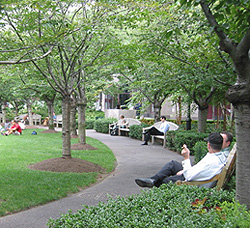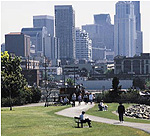|
|
|
|
|
|
|
|
|
|
|
|
|
|
|
|
|
|
|
|
|
|
|
|
|
|
|
|
|
|
|
|
 |
|
|
University of Washington
Department of Landscape Architecture
348 Gould Hall
Box 355734
Seattle, WA 98195
206.543.9240
last updated 5.06.06
Download this page as a PDF
|
|
|
|
|
|
|
 |
|
|
Mission Statement:
Open Space Seattle 2100 seeks to develop a comprehensive open space network vision for Seattle's next 100 years that will complement the city's predicted growth and density, and to build the broad constituency and strategies required to implement this vision.
|
|
|
What is Open Space Seattle 2100?
Open Space Seattle 2100 is a coalition of urban leadership that is sponsoring a public discourse and planning process to engage citizens in collaborative visioning of Seattle's future open space network. The University of Washington's Department of Landscape Architecture is joining with leaders and citizens from civic, environmental, professional, neighborhood and community groups to create plans for connected open space that will serve residents, businesses, and our natural systems for the coming century. The vision reaches from the city limits to the downtown core, creating a comprehensive network of parks, civic spaces, streets, trails, shorelines, and urban forests that will bind neighborhoods to one another, create ecological conduits from the city's ridgelines to its shorelines, and ensure a wealth of green spaces for all citizens to enjoy.
Public Lectures
The public discourse began with lectures on the planning and design of social, ecological, and equitable cultural spaces that form our civic "green infrastructure." All lectures were free and open to the general public. For a list of past and current lectures, please click here.
Developing the Visions
The centerpiece of the project was a 2-day planning charrette (workshop), on February 3 and 4, 2006. Planners, architects, landscape architects, engineers, neighborhood councils and activists, real-estate developers, artists, open space advocates, students and citizens-at-large were encouraged to participate. Teams focused on distinct areas of the city to discover and develop ideas for connected green streets, parks, trails, urban social spaces, waterfronts, recreational facilities and habitat. Students from the UW's College of Architecture and Urban Planning helped to prepare for, inform and facilitate the charrette, and further refined and coalesced the teams' proposals into comprehensive vision plans. Plans included implementation strategies and priority recommendations for near-term actions. These will be presented to the public in a May meeting at City Hall.
Next Steps
With broad citizen involvement and the support of city agencies and leaders, the charrette visions have attracted a strong constituency for implementation Open Space Seattle 2100 is initiating the next project phase, which includes combining the ideas into an overall city open space plan, developing a report that will be available to the public, and advancing adoption of priority policies and projects.
|
|
|
|
|
|
|
|
|
|
Why is Open Space Seattle 2100 important?
Seattle's population is expected to at least double within the next 100 years, adding another half-million people within the city boundaries, and this may be a good thing. Recent planning for the Puget Sound Region and King County emphasize that in order to conserve our remaining farms and forests we must concentrate population growth within existing communities. Otherwise, development will continue to sprawl, engulfing our last rural and wild places. |
|
|
|
|
|
|
|
But in order for Seattle to successfully densify, it must remain livable. To accomplish this, the city must possess an open space system that gives people access to social and green spaces where they live, commute and work. Our Olmsted-based park system, initiated in 1903, has supported the city's need for open space over the last century. Now, with open space and accompanying ecological functions at a premium, we must move toward a more inclusive and comprehensive vision of urban open space that makes use of every opportunity to create parks, gathering spaces, community gardens, recreational spaces, wildlife habitat, waterfronts, urban streetscapes, pedestrian trails, and bikeways and other low-impact transportation avenues. Such an inclusive and multifunctional open space vision will attract families and people of all ages to live in a more compact city, instead of sprawling over our remaining farm and forest land. A connected system will also provide habitat and passage for fish and wildlife at Seattle's critical location at the confluence of lakes, bays and two major watersheds. To create a livable city where people and wildlife thrive together, we must plan now.
|
|
|
How can I or my organization become involved?
1. Find out about the visions for your watershed study area. Attend the May presentation and Exhibit at City Hall. Download the team charrette products and watch for the final report on this website.
2. If you would like to help with Plan Implementation, contact open2100@u.washington.edu.
|
|
|
|
|
|
|
|
Public Lectures and Events
|
|
 |
|
|
|
|
|
|
Charrette Orientation + Technical Panel
moderated by Greg Smith of Urban Visions
Bertha Knight Landes Room at City Hall
Thursday, January 26, 5:30pm
Moderated by Greg Smith, this panel of technical experts will discuss a variety of issues that will face the city as we look into the next century. The panel includes Marina Alberti and John Marzluff from the University of Washington, Barbara Gray from the Department of Transportation and Steve Nicholas from the Office of Sustainability and the Environment, Karen Daubert of the Seattle Parks Foundation, Mark Huppert of Catapult Development, and Heather Trim of People for Puget Sound. Discussion topics will include future scenarios, aquatic and terrestrial habitat, innovative street right-of-way designs, open space connections, economic considerations and global climate change. Following the panel will be an opportunity for you to meet your Green Futures charrette teammates.
Mark Huppert, Catapult Development: Development Perspective
Marina Alberti, University of Washington: Future Scenarios
John Marzluff, University of Washington: Challenges to Terrestrial Diversity
KEYNOTE SPEAKER:
Patrick Condon, Associate Professor, University of British Columbia
Green Urban Infrastructure for the 21st Century
University of Washington Architecture Hall Room 147
Thursday, February 2 7pm
Professor Patrick Condon holds the UBC James Taylor Chair in Landscape and Liveable Environments. In that capacity he has organized a series of round table multi party planning and design processes in British Columbia and the United States. These efforts share the goal of creating more sustainable new and retrofitted communities. The work has produced approved and workable plans for providing thousands of new housing units and job sites in sustainable community contexts. See more information at: http://www.sustainable-communities.agsci.ubc.ca/staff.html
Robert Garcia
The City Project: New Open Spaces for Social Justice in Los Angeles
University of Washington Architecture Hall Room 147
Thursday, January 19 7pm
Mr. García is an attorney with extensive experience in public policy and legal advocacy, mediation, and litigation involving complex social justice, human health, environmental and criminal justice matters. He has influenced the investment of over $18 billion in underserved communities, working at the intersection of social justice, sustainable regional planning, and smart growth. He graduated from Stanford University and Stanford Law School, where he served on the Board of Editors of the Stanford Law Review. See more information at: http://www.clipi.org/ourwork/urbanparks.html
Mike Houck
Creating Livable Cities with Urban Green Space
Mike Houck, Director, Urban Greenspaces Institute, Portland State University. Houck will describe efforts to create a livable Portland-Vancouver metropolitan region through the enhanced protection and restoration of a vibrant green infrastructure. He will illustrate on-the-ground examples and tools the region is using to simultaneously ensure equitable access to nature, parks, trails and greenspaces; to maintain biodiversity; and to create higher density, compact urban form. These approaches include the Metropolitan Greenspaces Initiative, regional growth management strategies, and innovative watershed planning and stormwater management.
Urban Sustainabilty Forum
DJC Article
View the Mike Houck's Presentation here
Mark Childs, Professor, University of New Mexico
Designing Compelling Public Places
Mark Childs, Professor, School of Architecture and Planning, University of New Mexico. Childs will discuss how vital public places can be designed to serve as centers of joyful celebration, heartbroken communion, civic discussion, or for simply hanging out. In his book, Squares: A Public Place Design Guide for Urbanists, he helps designers, planners, public officials, students, developers and community leaders understand the history and theories of public commons, elicit community dialogue and desires, respond to the natural and built environment, and design compelling places.
|
|
|
|
|
|
|
|
|
|
|
|
|
|
|
|
|
|



